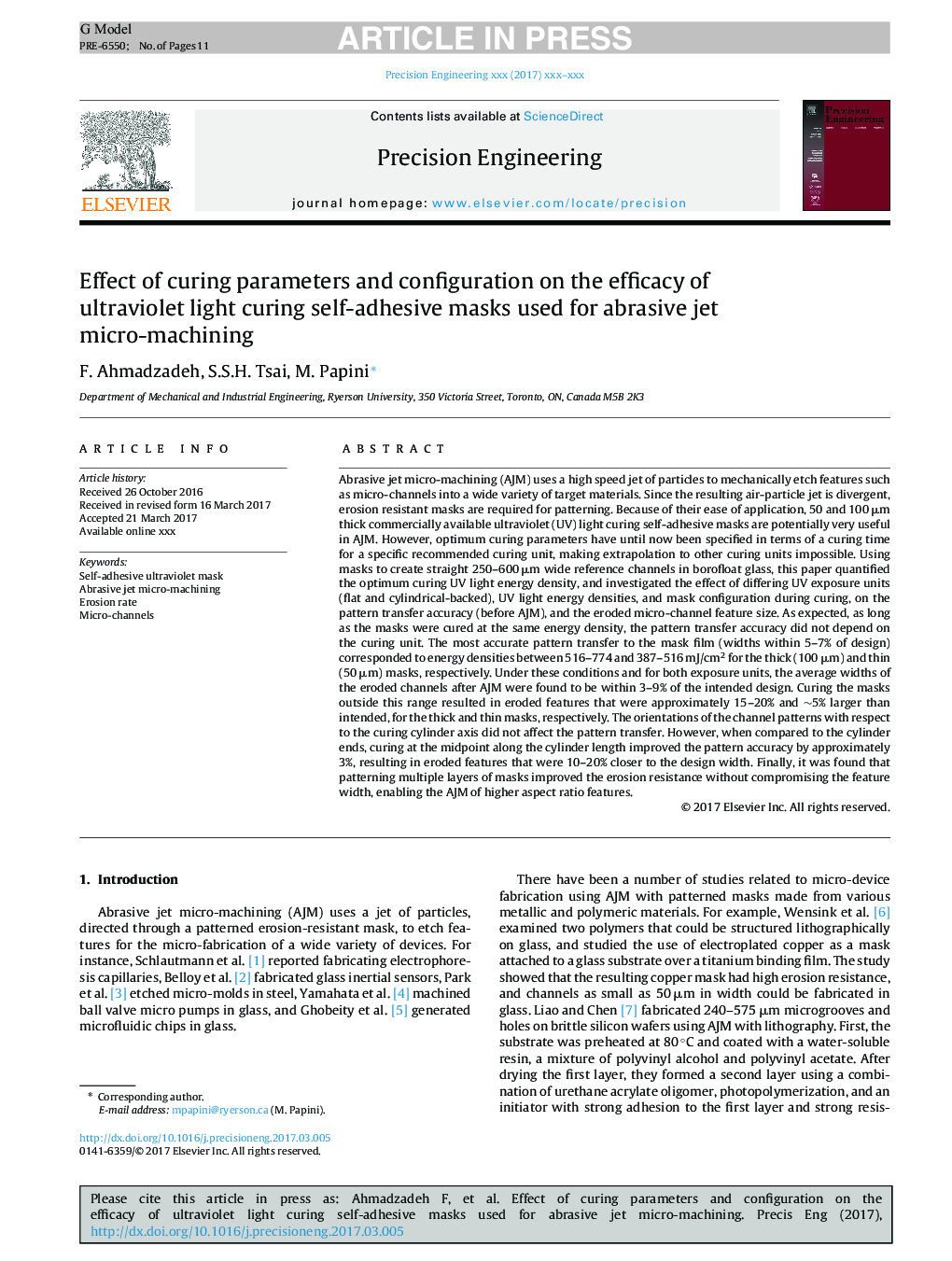| کد مقاله | کد نشریه | سال انتشار | مقاله انگلیسی | نسخه تمام متن |
|---|---|---|---|---|
| 5019113 | 1467839 | 2017 | 11 صفحه PDF | دانلود رایگان |
عنوان انگلیسی مقاله ISI
Effect of curing parameters and configuration on the efficacy of ultraviolet light curing self-adhesive masks used for abrasive jet micro-machining
ترجمه فارسی عنوان
اثر پارامترهای پخت و پیکربندی بر روی کارآیی ماسک های خود چسب دار از نور ماوراء بنفش مورد استفاده برای میکرو ماشینکاری ساینده جت
دانلود مقاله + سفارش ترجمه
دانلود مقاله ISI انگلیسی
رایگان برای ایرانیان
کلمات کلیدی
ماسک ماوراء بنفش خود چسب، میکرو ماشینکاری ساینده جت، نرخ فرسایش، میکرو کانال،
موضوعات مرتبط
مهندسی و علوم پایه
سایر رشته های مهندسی
مهندسی صنعتی و تولید
چکیده انگلیسی
Abrasive jet micro-machining (AJM) uses a high speed jet of particles to mechanically etch features such as micro-channels into a wide variety of target materials. Since the resulting air-particle jet is divergent, erosion resistant masks are required for patterning. Because of their ease of application, 50 and 100 μm thick commercially available ultraviolet (UV) light curing self-adhesive masks are potentially very useful in AJM. However, optimum curing parameters have until now been specified in terms of a curing time for a specific recommended curing unit, making extrapolation to other curing units impossible. Using masks to create straight 250-600 μm wide reference channels in borofloat glass, this paper quantified the optimum curing UV light energy density, and investigated the effect of differing UV exposure units (flat and cylindrical-backed), UV light energy densities, and mask configuration during curing, on the pattern transfer accuracy (before AJM), and the eroded micro-channel feature size. As expected, as long as the masks were cured at the same energy density, the pattern transfer accuracy did not depend on the curing unit. The most accurate pattern transfer to the mask film (widths within 5-7% of design) corresponded to energy densities between 516-774 and 387-516 mJ/cm2 for the thick (100 μm) and thin (50 μm) masks, respectively. Under these conditions and for both exposure units, the average widths of the eroded channels after AJM were found to be within 3-9% of the intended design. Curing the masks outside this range resulted in eroded features that were approximately 15-20% and â¼5% larger than intended, for the thick and thin masks, respectively. The orientations of the channel patterns with respect to the curing cylinder axis did not affect the pattern transfer. However, when compared to the cylinder ends, curing at the midpoint along the cylinder length improved the pattern accuracy by approximately 3%, resulting in eroded features that were 10-20% closer to the design width. Finally, it was found that patterning multiple layers of masks improved the erosion resistance without compromising the feature width, enabling the AJM of higher aspect ratio features.
ناشر
Database: Elsevier - ScienceDirect (ساینس دایرکت)
Journal: Precision Engineering - Volume 49, July 2017, Pages 354-364
Journal: Precision Engineering - Volume 49, July 2017, Pages 354-364
نویسندگان
F. Ahmadzadeh, S.S.H. Tsai, M. Papini,
